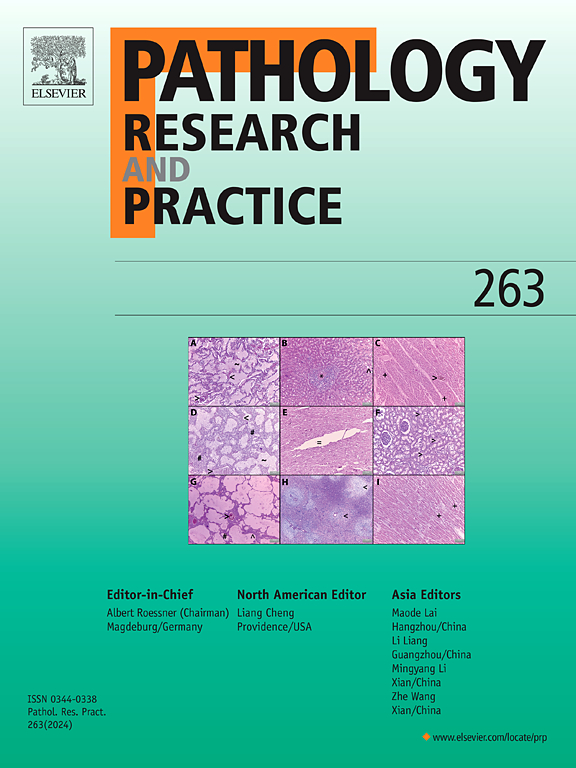The prognostic impact of PBRM1 immunohistochemical expression and its association with CD3 + and CD8 + immune cells in patients with renal cell carcinoma: A retrospective study
IF 2.9
4区 医学
Q2 PATHOLOGY
引用次数: 0
Abstract
The objective of this study is to determine the prognostic implications of PBRM1 immunohistochemical (IHC) expression in renal cell carcinoma (RCC) patients. Additionally, the objective is extended to evaluate the association between PBRM1 expression and CD3 + and CD8 + immune infiltrates. This study retrospectively reviewed 115 RCC patients who underwent nephrectomy. Immunohistochemistry was performed for PBRM1, CD3, and CD8. The associations between the studied parameters and variable clinicopathological characteristics, including survival, were analyzed statistically. A significant association was observed between the low expression of PBRM1 (< 50 %) and aggressive clinicopathologic features (p value around 0.001), as well as a significantly worse 3-year overall survival (OS) and disease-free survival (DFS) (p value around 0.001). PBRM1 low expression was considered an independent predictor of shortened DFS in multivariate analysis (p = 0.030). In addition, PBRM1 expression was incorporated into the SSPN scoring system (stage, sarcomatoid, PBRM1 expression, and necrosis) for recurrence risk stratification. The four risk groups exhibited substantial disparities in OS and DFS (p < 0.001). Moreover, a robust correlation was observed between the high density of immune infiltrate (number of CD3 + and CD8 + immune cells/mm2) and the low expression of PBRM1 (p < 0.001). In conclusion, poor prognosis and tumor progression are strongly associated with a low expression of PBRM1. Postoperative recurrence can be accurately predicted by the SSPN score, which incorporates PBRM1 expression and clinicopathologic findings. Patients with high-risk factors associated with low expression of PBRM1 and a dense inflamed microenvironment could potentially benefit from effective immunotherapy and target treatment.
求助全文
约1分钟内获得全文
求助全文
来源期刊
CiteScore
5.00
自引率
3.60%
发文量
405
审稿时长
24 days
期刊介绍:
Pathology, Research and Practice provides accessible coverage of the most recent developments across the entire field of pathology: Reviews focus on recent progress in pathology, while Comments look at interesting current problems and at hypotheses for future developments in pathology. Original Papers present novel findings on all aspects of general, anatomic and molecular pathology. Rapid Communications inform readers on preliminary findings that may be relevant for further studies and need to be communicated quickly. Teaching Cases look at new aspects or special diagnostic problems of diseases and at case reports relevant for the pathologist''s practice.

 求助内容:
求助内容: 应助结果提醒方式:
应助结果提醒方式:


